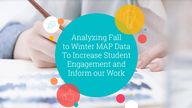
Return to flip book view
Agenda▪ Analyze our fall to winter data together.▪ Identify strategies that have contributed to student success.▪ Identify strategies that have contributed to teacherefficiency and success▪ Kelly and Samantha will share the strategies they plan to use to address needs uncovered in their winter data.▪ Collaborate to design learning experiences that address the student learning needs we uncover tonight.
Our Fall Strategies Maximize Winter Benefits
Sample Goal Setting Sheet for Primary Studentshttps://poway.instructure.com/courses/50982/pages/goal-settingTeachers can find reflection sheets and goal setting sheets for all grade levels in the the PUSD Learning Center.
Why Examine Winter Reports?▪ Excellent data for student reflection, self-assessment, and building connections between hard work and growth achieved.▪ Great opportunity to honor growth and reexamine our goals. Modeling a Growth Mindset!▪ An objective overview of what’s working well.▪ Insight for areas that need additional instructional support▪ Valuable information about strengths and weaknesses in our adopted texts and resources
Where Are All the Reports and Tools?▪ No more frustration over where to find the reports and data we need.▪ Login to MyPlan and click on the the Student Report Center. Parents can access these reports as can students in grades 3 and up.▪ myplan.powayusd.com
For Tonight: Print Your “Analyzing Fall to Winter Class and Student Growth Report.”
Analyzing Class Growth Data▪ Take a highlighter and circle the goal area your class has been targeting in reading, math, and language usage
Taking a Closer Look:For the next 10 minutes, answer the following questions on page one. Then take 5 minutes to discuss your discoveries with partners at your table. Be prepared to share your group’s insights.
Also Print the ASG Report(for our next steps)
Analyzing Mid-Year Individual Student Growth
FAQs:▪ What are expected growth and optimal growth targets?
▪ What percentage of students normally make typical growth?▪ 29-39 : before we had access to MAP data▪ 40-59 : beginning use ▪ 60-100 : proficient use of data class/student goal setting, strong instructional strategies, differentiation, personalization, student ownership and engagement)FAQs:
FAQs:▪ Why do some students’ scores go down and what can we do about it?
Why Scores Drop…▪ NWEA reports the following:▪ The student took too little time on the second test ▪ The student was not engaged during the test▪ The student received little or no instruction in the appropriate RIT range since the previous assessment
Why Scores Drop▪ We’ve Noticed:▪ It’s important to look at the goal areas for each student. For example, when our students grew dramatically in Interpretive Comp skills, they often fell in Literal Comp skills.▪ Students sometimes become focused on learning more in one area and need support to integrate the new skills across the subject area▪ We sometimes overemphasize areas when we notice unique needs. (Interpretive Comp, Response to Literature)▪ New textbooks may have areas of weakness and we need to find support materials to balance them▪ Students may need support to take the risks necessary to promote growth
Lessons Learned from Bruce Torres+11+18+22+12 +12+15-12+20+28+26+3+27+11+27
FAQs:▪ Why do more of my GATE students show a drop in scores while my Basic and Proficient students make great progress?▪ Let’s look at underlying goal areas▪ Computer Adaptive Assessment▪ Are we teaching what they’re ready to learn?
FAQs:▪ What does it mean when the scores from some students go up much more than expected?
For Real Answers: Ask Students
Give Students Opportunities to Reflect on What Worked:
Team Up to Lighten the Load And Support All Our Students
Using The Learning Continuumto Go Deeper
Another Great Resource: Vocabulary and Concepts to Learn▪ Login to the the PUSD Learning Center in MyConnect▪ Click on the Overview of MAP Resources and Best Practices
Take Time to Honor Growth▪Share successes▪Remember, it’s about students and learning, not the numbers!!!
New Discoveries and Questions